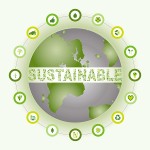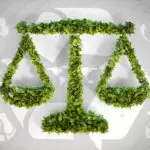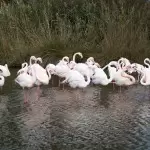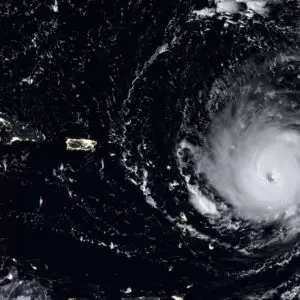
What is Meteorology?
Meteorology is one of the most important atmospheric scientists yet one that most of us do not think about. When we do, our immediate thought is to its usefulness in predicting weather. Yet it covers all aspects of the atmosphere, including atmospheric physics and chemistry (1). Humanity has always had (and needed) an interest in the weather, but today it encompasses far more than predicting weather patterns. The word meteorology comes from (as most do) Greek, meteoros "high up” and logia "the study of”. Therefore, the word means "the study of things high up / in the sky."
Its most powerful uses are in weather prediction by looking at such phenomena as localized temperatures, water vapor levels, fluctuations in air pressure, wind direction and their responses to Coriolis Effect. It seeks to predict what a weather system is going to do, even when otherwise seemingly erratic, to determine what conditions will be like over the next few days to a week, locally, regionally and even nationally. Such simple predictions sometimes have massive implications for workers in many fields coming to rely on these predictions. Meteorology is largely correct, but sometimes it goes wrong, showing just how reliant we are on understanding the weather around us. When they do get it wrong, it simply points to how erratic weather can be. Increasingly though, the tools and methods point to a high level of accuracy (2).
It is not the study of meteors; the name may confuse some because they have the same source. The principles are similar though. Both come from “high up”.
A History of Meteorology
In Antiquity
Meteorology is one of, if not the, oldest atmospheric science; there is a good reason for this. Farms in early civilizations needed to understand weather patterns for their ancient agricultural practices. Farmers depended on the right weather conditions for planting and the harvest. It is no great surprise that the earliest texts that describe cloud formations, rainy and other seasons and attempt to make sense of them for weather purposes date to 3000BC and the Indus Valley, one of the earliest human civilizations (3). That document is called the Upanishads; although a sacred text to Hindus, Jains and Buddhists, its observations on weather systems was quite remarkable.
Ancient Egypt's knowledge was unsurpassed in many ways. Their year was divided into three seasons - all focusing on meteorological events. The first was the period of “inundation” (flooding) of the Nile. They relied on this annual inundation to speculate on crop abundance at the harvest. Too little inundation created famine; too much led to flooding and crop failure. They did not, however, understand the meteorological processes that caused the Nile to flood. They did understand the importance of the changes of the season, examining the indicators that might suggest how a given year's flooding might look - and looked for those indicators in predicting how much the Nile would flood (4).
There is evidence all over the globe that ancient civilizations valued the meteorological seasons and events. For example, the Mayan Observatory at Chichen Itza, Mexico monitored the movement of the planets, but evidence suggests this was the plan agricultural seasons (5). Wind vanes have been discovered in ancient Mesopotamia (6), and ancient Chinese civilizations kept meteorological records (7). A much later Chinese philosopher by the name of Wang Chong would determine that rain came from clouds and not as spontaneous phenomena. In most places, most times, these were considered supernatural events - angering the gods or spirits, or in some cases, receiving their favor. Even ancient societies understood the need for rain for crops. Initially credited with theorizing the idea of evaporating water creating clouds, it's now understood that Chinese thinkers knew this way before his time (13).
Ancient Greece and Rome
The influence, reach and power of the Greek city-states and the Greek Empires spread across and beyond the Mediterranean world. Later, The Roman Republic and then the Empire would dominate much of this land and much more. Neither could have truly expanded their influence without meteorology.
As early as 600BC, Thales of Miletus was issuing forecasts for crop harvest, famously buying an olive press ahead of a bumper crop. He was right and made his fortune (8). Aristotle wrote about the weather in his book Meteorology (9) which is now considered the first true account and explanation of weather systems. He made many observations, but it lacked the scientific method common today for accurate predictions. He credits Thales of Miletus for the work and, in turn, inspired many more ancient meteorologists, not least of all his own pupil Theophrastus who published the first book on weather forecasting (10). The work was so thorough and so seminal, it would prove to be the most useful book on the subject ever written until the Age of Enlightenment.
What is clear is that these ancient societies understood some of the basic conditions that could point to the weather and meteorological phenomena acting in certain ways. But Greek and Roman interest and advances in meteorology did not end with those above. Later, Archimedes examined and understood what we know today as the buoyancy and the Hydrostatic Principle. Together, they dictate not only how clouds form, but which clouds form given the conditions - and it was all based on simple observations of early understanding of physics. This was one of the earliest methods of predicting the weather to follow based on cloud types (11).
There are precious few important figures then until the later years of the Roman Republic. Their advanced civilization understood enough about weather systems to employ an imperial geographer. One particular geographer of note was Poponeius Mela who observed and described climatic zones and their associated weather systems and patterns (12). Later, this would become crucial in predicting localized weather patterns and understanding the varying conditions of different ecological zones.
The Medieval World
Much of what the ancient world understood about meteorology continued to be influenced by the ancient knowledge already accumulated in both east and west. China and the civilizations of the Indus Valley continued to be influenced by works there and with increasing contact with Eastern Europe (the side of the Roman Emperor later known as Byzantium). Meanwhile, in western Europe, work from the ancient scholars are largely ignored until the Renaissance. Most work in this period is simple observation; no seminal early scientific works are yet in progress. But in the Middle East, something called The Muslim Agricultural Revolution is taking hold. It will influence civilizations to the east and the west and it was all down to a very early naturalist called Al-Dinawari (14).
It promoted a more naturalistic view of the world in crop growth and the seasons. Al-Dinawari went into great detail about lunar phases, rain, seasonal change, and examined - arguably for the first time - natural erratic atmospheric phenomena including storms, high wind, flooding, snow, and other natural processes that lead to crop growth volatility. Even more remarkable, he was a naturalist in the Middle East some 800 years before it would become a trend in the western world. He is largely credited as one of the earliest ecologists (15). While most works came out of the Islamic Middle East in this period, much of it built on the traditions of the likes of Aristotle, Archimedes and Galen - philosophies, natural phenomena and also early pharmacology. Some of these aspects are tied to meteorology.
That's not to say that Europe was without its thinkers at this time. Roger Bacon is seen as an early polymath and credited with the invention of the empirical method, although science would not see its value for another 450-500 years. Some of his beliefs about the world were kooky, but his interest in atmospheric physics - even if he could not explain them naturalistically, played a small part in meteorology. He had a particularly strong interest in rainbows and their appearance, insisting they were caused by reflected light resulting from natural processes (16). Bacon built on the work of St Albert The Great who theorized their creation resulting from the shape of a raindrop and its ability to refract light.
They say there are only two guaranteed things in life: death and taxes. In Korea, the invention of the Rain Gauge in the 1440s suggests an understanding of the complexity of rainfall with agriculture. The tool was used primarily to assess taxes on farmers for King Sejong. The invention was his son's - Prince Munjong - based on a lifelong interest in meteorology and correlating drought and flooding with poor harvest (17).
The Renaissance to 18th Century Enlightenment
Most scholars between the medieval period and the Renaissance were interested in weather phenomena, but these tended to continue to be observations such as Christopher Columbus' description of a cyclone in the central Atlantic during his journey to the Americas. But as with most things, we need to look at some of the greatest minds of Renaissance Europe. Some argue that the collapse of the Byzantine Empire in the east led to a flood of scholars from east to west, triggering the Renaissance and eventually the Enlightenment. One of the greatest names in Europe in this period was Galilei Galileo. In 1607, he is believed (but not confirmed) to have constructed something called a Thermoscope (18). It's a simple device that records temperature change, much like the modern thermometer but much simpler, and there was no grading (Farenheit, Celsius, Kelvin) until much later. Regardless of who invented it, it represents a change in thinking. Until that point, heat and cold were considered natural fluctuations in the elements.
But the birth of modern meteorology begins, as many sciences do, in The Enlightenment - when tremendous advances in the sciences improved knowledge and education. The usual names come up in the wake of Galileo. Famous early astronomer Johannes Kepler wrote a treatise on snow crystals; slightly later, Renee Descartes defined snowflake morphology (19). The first barometer follows before 1650 (20) - and like modern models it used mercury to register temperature change. The later 17th century saw an explosion in the science. Another astronomer, Edmund Halley after whom Halley's Comet is named, devised the first predictions of regional wind systems by proposing a theory of trade winds, studying the processes that form monsoons (21). From there, the young science stopped being concerned entirely with localized weather conditions and began to look at large-scale processes that inform weather systems. His calculations, although improved, still form the basis of large-scale wind-based weather patterns today. Other names from the period are Gabriel Fahrenheit and Anders Celsius after whom the two most common temperature scales are named.
The 19th Century
Building on the temperature scale, systems came into force to determine wind speed (The Beaufort Scale); it is still used today by all major weather forecasting offices (22). and in 1817, the first global temperature map is published by Prussian polymath Alexander von Humboldt (23). This is considered the first ever climate report and his interests in pressure, temperature, currents, magnetism would form the basis of modern meteorology, but also a whole new atmospheric study that would eventually lead to climate science (23). Shortly afterwards, the first cartographic weather reports (weather maps) would begin appearing. This was the invention of another German scientist, one Heinrich Wilhelm Brandes. Today, he is credited as the founder of Synoptic Meteorology, a scale we still use today. When viewing a weather report, the scale of lines that appear on the map denotes air pressure. This is the Synoptic Scale (24) and it predicts large-scale weather patterns.
Another name familiar to meteorologists should be Gaspard-Gustave Coriolis although he was not, by trade, a meteorologist. He worked during the Industrial Revolution and theorized how revolving parts of new machinery could be designed for greater efficiency. An unexpected by-product of this theoretical engineering came in meteorology when his contemporaries realized that his theory applied to weather systems over large areas based on the planet's rotation and wobble during the seasons. Now, this system is named after him as “The Coriolis Effect” (25).
The late 19th century was the beginning of the establishment of most meteorological services following the world's first International Meteorological Conference in 1853. By the beginning of the 20th century, most countries in the developed world had a society dedicated to the study of weather patterns and local climate conditions. The UK's Met Office was the first in 1854. The US Weather Bureau began in 1890 as a division of the Department of Agriculture. International organizations sprang up quickly with the International Meteorological Organization beginning in Vienna in 1873. This lasted until the 1950s when replaced with the World Meteorological Organization.
Meteorology in the 20th and 21st Centuries and Beyond
The 20th century continued the expansion of the science. Changes in technology included the dawn of radio. This was useful for transmitting public weather forecasts and weather warnings for extreme weather events, allowing everyone to benefit. Later, telemetry would be able to transmit information instantly from various weather stations to the growing number of media outlets. Also, for the first time, mathematical principles began applying to meteorology (26), improving prediction in forecasting although the Chaos Theory that would later come to underpin the erratic nature of weather would not come in until the 1960s. This became necessary for the push towards intensive farming in the developed world so agricultural workers could take the right measures for their work.
Some war technologies proved useful too; radar, for example, allowed Royal Air Force pilots to fly at night during bombing raids on the European continent and to detect enemy aircraft, but meteorologists quickly found it had a use in weather patterns (27). Satellite imagery also began its life in the immediate post-war years through to the 1970s. Today, satellites provide up to the second photographic images of weather systems, allowing for changing prediction based on the sometimes chaotic fluctuations of weather fronts. A growing environmental movement in the late 19th and early 20th century came to a head in the 1960s. We now understand that climate change leads to erratic and extreme weather (28). This was the time researchers began to understand the potential to shift entire ecosystems and lead to long-term ecological change.
Our modern understanding of weather patterns and regional change is based on some of the best tools presently available to us. Digital mapping in the form of Geographic Information Systems (GIS) and modern radar do not just predict what the weather will be like tomorrow, but allows us to examine weather systems while they happen. That allows meteorological offices all over the world to offer changing status on erratic weather systems and offer safety advice (1). In the 21st century with extreme weather arguably exacerbated by climate change, their importance is way beyond what the weather will be like tomorrow.
Explore an Online Degree in Meteorology >
Uses of Meteorology
Weather forecasting
The most obvious public face of the science of meteorology is in weather forecasting. Every time we turn on the news to understand how our local weather is going to look for today or next few days, we are utilizing one of the most common applications of meteorology. It applies many scientific methods and tools in attempting to predict, through atmospheric indicators, how the weather conditions will look one hour, one day or one week from now. The further into the future, the more erratic and less predictable the conditions become.
Meteorologists who work in this area collect quantitative data (mathematical information and statistics) on such information as air pressure, present weather, wind in the different levels of the atmosphere to create forecast models based on recognition of past patterns, mitigation of model bias. Weather people often get predictions wrong because of something called “Chaos Theory” (the concept that conditions can change wildly based on minor fluctuations in conditions) (29). Newtonian physics once determined that systems were stable, but Einstein determined they are erratic, unpredictable (to a degree) and subject to external influences based on minute changes. Multiple models are used today to increase accuracy and super-fast computational processes can highlight up-to-the-minute changes.
We rely on weather warnings - for tornados, hurricanes, flooding, heavy rain and snow etc. for safety advice, protecting our lives and homes too.
Commodity Trading
Perhaps one of the most surprising ways in which meteorology is applied is in commodities trading. Stocks and shares trade is one area of employment for meteorologists, especially when the dealing with commodity crops such as coffee (affected by adverse weather conditions) and fuel (we use more in unusually cold winters) (30). These organizations trade based on longer-term weather forecasting and what a crop harvest is going to look like in a certain year. Thales of Miletus (discussed earlier in the article) was perhaps the first person to do this when he predicted a bumper crop for olives, bought a press, and made a lot of money in the process. It's an inexact science, because weather conditions that will create a bumper harvest for one crop may prove destructive for another. There are many examples of how meteorology has presented speculators with opportunities to make money.
Even smaller businesses such as clothing retailers and restaurants are utilizing data from meteorological data specialists. Targeted advertising is set to go out at certain times such as commercials for wet weather clothing during unusually wet weather and sun cream during unusually warm weather, not just based on typical seasonal trends.
Aviation Meteorology
This division of meteorology deals with military and commercial flying and weather conditions in the upper levels of the atmosphere. Even when the weather is good at ground level, it doesn't mean the same conditions apply 30,000ft. Aviation meteorology is the applied science that dictates air traffic - whether a route is safe or dangerous, at what times, and whether flights can be made at all (31). They will disseminate data about head and tail-winds, temperature changes, ice buildup (which can damage aircraft performance) and variation on the ground, air pressure variation across the world and through the atmosphere, visibility and local conditions advisory systems for pilots. They can dictate when it's unsafe to take off or unsafe to land (and find alternate airports such as the eruption of the Icelandic volcano in that causes havoc across North America and Europe (32).
Agricultural Meteorology
Few industries and areas of our lives are as dependent on changes in weather conditions as agriculture. Crops for food and for clothing are necessary to live and for business, providing livelihoods for those who grow crops - not just food, but also commodity crops such as cotton and coffee. Meteorology determines when farmers should sow, when they should reap, and what steps they will need to take to protect crops from erratic weather. They may need to engage in flood mitigation or effective water management during drought to protect from crop failure.
Throughout the season from sowing to harvest, farmers and agricultural workers must engage in proper crop management and monitoring. This means effective watering or drainage but also includes ensuring the right nutrients remain in the soil for the crop and for the season but is also based their forecast crop yields on weather conditions and how quickly they may respond to changing patterns (33). Neither does meteorology just apply to crop management; livestock management for milk production depends on weather conditions too. Finally, some use agricultural meteorology as an applied science to determine the relationships between a local environment, crops, soil types, soil profile, and understanding which crops can and cannot grow in certain types of soil.
Environmental Meteorology
Environmental meteorology is concerned with the study of pollution and its effects on the climate as a forcing of local, regional and national weather patterns. It will look at such aspects as variation in temperatures, water vapor density (humidity), speed and intensity of wind, and many other weather conditions and phenomena. It will also look at the physics of meteorological processes of acoustical, electrical, optical, and the thermodynamic processes of the atmosphere. Cloud formation, precipitation, weather conditions and much more. Rather than looking at just the weather conditions resulting from meteorology, it also examines the potential impacts of weather conditions on the environment and on climate. Extreme weather can change a landscape significantly and therefore alter the weather patterns. Long-term and large-scale modelling, data accumulation and analyses and modelling feature heavily in environmental modelling (34).
Hydrometeorology
This is the subdivision of meteorology that fuses with the science of hydrology, examining how water transfers from dry land (evaporation) and lower echelons of the atmosphere. This examines cloud formation and the processes that lead to water-based natural phenomena, but it also predicts, projects and studies water hazards such as flooding and tropical cyclones, but also the effects of drought and land desertification - all these things concern precipitation and hydrology. Common applications behind this branch include “the water budget” (35) - the account of all water transferring in or out of a water asset. Too much and it will flood, too little and drought ensues. Hydrometeorologists also monitor variation, quantity, intensity and distribution of rainfall. Examination of snowstorms also falls within the remit of hydrometeorology
This is multidisciplinary, using applied math, statistics, but also computer data modeling. Problems with the cross-disciplinary approach and lack of broad expertise are being addressed by some projects such as DRIHM which aims to use big data and broad methodology to improve hydrometeorological forecasting for the future (36) and mitigate the effects of extreme weather. That EU project finished in 2015, but its results will be useful for decades to come.
Synoptic Meteorology
As discussed above, the Synoptic Scale is the series of lines we see on a weather forecast map. Rather like contour lines on a map, how close or far apart they are, determines the weather pattern. In cartography, these contours denote the steepness of the elevation. In meteorology, they serve a similar purpose - denoting density. Synoptic Meteorology examines large-scale weather systems and their impact on larger areas (24). It looks at the systems that form to create hurricanes and cyclones, including weather fronts, their directions and jet streams. Conditions must be right from a variety of directions and sources to determine whether or not a certain weather system will develop. It examines the structures of the atmosphere and its behaviors in attempting to forecast systems. Weather forecasting needs to look at the conditions way beyond the area of study to understand what the weather may be like in a certain area. Synoptic Meteorology, then, takes a broader view.
Maritime / Marine Meteorology
Where conditions on land are vital for agricultural workers, those who work at sea - industrial fishing, oil and gas rigs, military navy, commercial shipping, all need up-to-date information on the weather conditions where they are or where they are going to dictate operations. They need to take action to avoid or mitigate the effects of extreme weather at sea, such as storms and hurricanes, cyclones, icebergs, the jet stream and much more. For commercial fishing, the problems can go beyond merely avoiding terrible storms in the name of safety. Business decisions must be made while taking on board changes in sea and freshwater weather systems. Even after these conditions have passed, fish stocks may be higher or lower than they were prior to the storm. Such information is also required for leisure boat activities and public transportation across water bodies (37). This information is not just useful for people who work at sea; many weather fronts develop on the ocean and then hit land, affecting activities on the shore.
Military Meteorology
Armed forces all around the world rely heavily on weather conditions and meteorological forecasts to plan military operations and training exercises. Some of the biggest upsets in military history have come from adverse weather conditions. In World War II, the Nazi Regime troops were held back by an advancing Russian winter at Stalingrad. A century earlier, Napoleon had the same problem. The Spanish Armada's proposed invasion of England in 1588 failed because of storms in the channel - so did Julius Caesar's invasion of Britannia. On the flipside, the D-Day landings in France during WWII were meticulously planned and executed after lengthy examination of the weather conditions in the English Channel. Originally set for June 5th 1944, commanders postponed due to weather warnings from meteorologists. At the time of the postponement, the weather was calm, but it did turn bad around the originally proposed time of mission launch (38). No matter how well-trained the forces, military commanders the world over do not underestimate the impact that weather conditions can have (39).
Nuclear Meteorology
How do we detect radioactive particles in the atmosphere? How do we determine their impact on the environment? Radiation is a natural phenomenon; this young subdivision of meteorology arose during the 19th and 20th centuries as humanity began to understand radiation waves, their sources and effects, and of course the results of nuclear testing since the 1930s. Nuclear meteorology investigates the distribution of radioactive gases and aerosols. They are present at nuclear energy production facilities, monitoring the reactors for radiology leaks and predicting their effects on the environment (40). They work to ensure environmental compliance at any facility where nuclear technology is in use. Most of all, they monitor pollution distribution by examining air currents and turbulence and predicting where the material will spread. They were integral to examining the spread of nuclear material following the meltdown of Chernobyl and relaying reports to European governments about the disaster (41).
Renewable Energy
As supplies of fossil fuel run out, the world can expect to move increasingly towards renewable energy. In 2018, this is a growth area but has a long way to go to catch up with conventional energy use. Most renewable energy sources are highly dependent on weather conditions. In some cases, that begins from even before the resources are planned and built. Wind farms need to be placed in areas used experiencing high winds. Solar farms need to go in areas that get a lot of sunshine. Hydroelectric power requires regular, sustainable and predictable water sources. Meteorologists examine local weather system history to determine sites of best placement. They must also take into account freak, erratic and variation in weather. Calm weather reduces the capacity of wind turbines, overcast, cold and wet weather reduce solar panel effectiveness, and drought will reduce the effectiveness of hydroelectric systems. Biofuel such as elephant grass needs the right climate and weather conditions for a sustainable crop and long-term productivity (42). In cold weather conditions when demand is high, there is potential for production to be low depending on the methods used. Finally, errors in forecasting can lead to reduced accessibility and lost money for producers. Therefore, renewable energy planning and development is and will remain fundamental to renewable energy at every stage.
Extreme Weather and Disaster Management
Extreme weather is a fact of life. California‘s ongoing drought and forest fires continue to spread year on year (43). Hurricanes such as Katrina cause high winds and flood urban centers. In 2017, no country was untouched by natural disaster somewhere within its borders. Meteorology is useful in examining and planning the spread of extreme weather beforehand and offering advice before it happens, the science is just as important during and after. Disaster relief organizations such as FEMA need to understand weather conditions while they plan relief efforts. As with military meteorology above, the weather alone can be the difference between success and failure. When weather conditions are part of the plan with a disaster relief strategy, professionals are able to provide relief where they can and to do so safely without risking the lives of recipients or their own. Planning will often begin days in advance to see when the worst conditions have subsided and may be subject to change each day with fluctuating weather conditions.
Meteorological Methods
Persistence Forecast
This is the simplest method to use and comes in quite useful (44); it starts with an assumption that present conditions will not change. Based on season expectations and averages, the weather tomorrow will be much the same as it is today. This works best in areas where the weather is not volatile or where it changes slowly. Southern California is a good example of this where conditions rarely change and seasonal alterations are less volatile and incremental with little variation noticeable on a day-to-day basis. Ideal for short-term forecasting, its limits are usually exposed when unusual weather fronts move in. It is not particularly useful for long-range forecasting.
Trends Forecast
The trends forecasting method examines direction and speed of weather fronts, pressure bars, and cloud and precipitation build-up (45). This data is used to predict what the weather will be like in a certain area in a few hours or days based on what it is like now elsewhere. This relies on understanding of the conditions that cause a condition to intensify or dissipate as it progresses. This is best used to predict rain fronts. They will examine such elements as wind speed to predict when they will arrive. Weather is fairly predictable but can be subject to fluctuation based on the chaotic nature of new fronts forming and other forcings.
Numerical Weather Prediction
One of the most recent developments, it uses applied math to define weather conditions, patterns and trends. Today, meteorological organizations use computer modelling to on powerful computer systems to output a large number of predictions on all manner of atmospheric conditions (46). This hard data is then used to predict potential weather conditions short and long-term, and short and long-range. These supercomputers process thousands of computations every second to provide up-to-the-minute forecasts. They are not always right, but weather forecasts are right more often than not thanks to these computerized predictions. Often, errors are down to human error in inputting, insufficient data, and the chaotic nature of present weather conditions. When the equations are at fault, so will be the results. Other problems with the method include the lack of data from extreme environments. It's often difficult to acquire data from the middle of the ocean and tops of mountains, but satellite imagery can alleviate some of these problems.
Analog Method Forecasting
This is a method of comparison. In many ways, it is the opposite of Persistence Forecasting and works for some climate types more than others - particularly where erratic weather is common. Forecasters look to a date in the past (usually in the same season) to predict what the weather will be like tomorrow based on past experience. The assumption is that the change in weather pattern will mirror that of the past (46). If the weather is warm today but there is a change in wind direction or a cold front heading towards you, rather than assuming it will remain warm, forecasters will look for situations in the past where the same thing happened and attempt to predict how the weather might change. This can work well in predicting storms and other intense weather fronts. It has its problems, mostly because it relies on uniformity; if the weather has proven anything, it's that it is rarely uniform.
Climate-Based Methods
Our understanding of meteorological phenomena now has a new variable: climate change (46). We know that weather condition are changing globally based on carbon emissions. It's understood that a warming climate will not lead to uniform warming everywhere. Some will become warmer and wetter, some warmer and drier. Some will experience slowing of their ocean jetstreams and experience cooling - colder and wetter weather. Global climate change has the potential to change not just weather conditions, but change regional rules too. Erratic weather will become common and systems we have come to rely on to determine weather patterns may become near-useless. As the climate changes, meteorologists need to take seasonal averages over many years to understand what the weather might be like today or tomorrow or to predict long-term forecasts for future developments. This can also inform medical sciences and the spread of epidemics (47).
Explore Careers in Meteorology >
Sources
- https://www.metoffice.gov.uk/about-us/what/what-is-meteorology
- https://blogs.scientificamerican.com/guest-blog/when-the-weather-forecast-is-wrong-don-t-shoot-the-messenger/
- http://www.imd.gov.in/pages/about_history.php
- https://sciencing.com/did-ancient-egyptian-farmers-nile-flooded-18466.html
- https://www.nasa.gov/audience/foreducators/5-8/features/F_Traditions_of_the_Sun.html
- https://journals.ametsoc.org/doi/abs/10.1175/1520-0477%281983%29064%3C1141%3AWVIAMA%3E2.0.CO%3B2
- https://journals.ametsoc.org/view/journals/bams/60/4/1520-0477_1979_060_0313_mrfaco_2_0_co_2.xml
- http://serious-science.org/greek-and-roman-meteorology-8624
- https://ebooks.adelaide.edu.au/a/aristotle/meteorology/
- http://rammb.cira.colostate.edu/dev/hillger/ancient.htm#biruni
- https://www.grc.nasa.gov/www/k-12/WindTunnel/Activities/buoy_Archimedes.html
- http://www.iep.utm.edu/wangchon/
- http://www.ishim.net/ishimj/2/03.pdf
- http://sites.utexas.edu/butzer/files/2017/07/Butzer-1994-IslamicTradiationAgeroecolog-1.pdf
- https://www.jstor.org/stable/227962?seq=1#page_scan_tab_contents
- http://galileo.rice.edu/sci/instruments/thermometer.html
- https://www.its.caltech.edu/~atomic/snowcrystals/earlyobs/earlyobs.htm
- http://www.physiology.org/doi/full/10.1152/physiol.00053.2012
- http://www.caltech.edu/news/caltech-scientists-offer-new-explanation-monsoon-development-1449
- https://www.weather.gov/mfl/beaufort
- http://libweb5.princeton.edu/visual_materials/maps/websites/thematic-maps/humboldt/humboldt.html
- https://www.weather.gov/jetstream/synoptic_intro
- https://www.nationalgeographic.org/encyclopedia/coriolis-effect/
- https://earthobservatory.nasa.gov/Features/Bjerknes/bjerknes_2.php
- http://www.physics.uwo.ca/~whocking/p103/radar.html
- https://www.scientificamerican.com/article/climate-change-and-extreme-weather/
- https://fractalfoundation.org/resources/what-is-chaos-theory/
- https://www.inc.com/articles/201103/outsmarting-mother-nature-and-targeting-consumers.html
- http://www.eurocontrol.int/met
- https://volcanoes.usgs.gov/volcanic_ash/ash_clouds_air_routes_eyjafjallajokull.html
- http://www.michigan.gov/documents/deq/wrd-water-budget_565040_7.pdf
- http://www.drihm.eu/
- https://www.accessscience.com/content/maritime-meteorology/407010
- https://www.metoffice.gov.uk/news/in-depth/d-day-70th-anniversary
- http://www.irsn.fr/EN/publications/thematic-safety/chernobyl/Pages/The-Chernobyl-Plume.aspx
- https://rmets.onlinelibrary.wiley.com/doi/pdf/10.1002/wea.2066
- https://ane4bf-datap1.s3-eu-west-1.amazonaws.com/wmocms/s3fs-public/programme/brochure/DRRRoadmap.pdf?02bPNJK9PBExfsfOvqDopUwM_UCeG4UC
- http://ww2010.atmos.uiuc.edu/(Gh)/guides/mtr/fcst/mth/prst.rxml
- https://www.icao.int/safety/meteorology/amofsg/AMOFSG%20Meeting%20Material/SN%2021%20Binder1.pdf
- http://ww2010.atmos.uiuc.edu/(Gh)/guides/mtr/fcst/mth/oth.rxml
- http://journals.plos.org/plosntds/article?id=10.1371/journal.pntd.0001470
- Guide to Parasitology - November 19, 2018
- Deserts as Ecosystems and Why They Need Protecting - November 19, 2018
- Conservation: History and Future - September 14, 2018
Related Articles
Featured Article
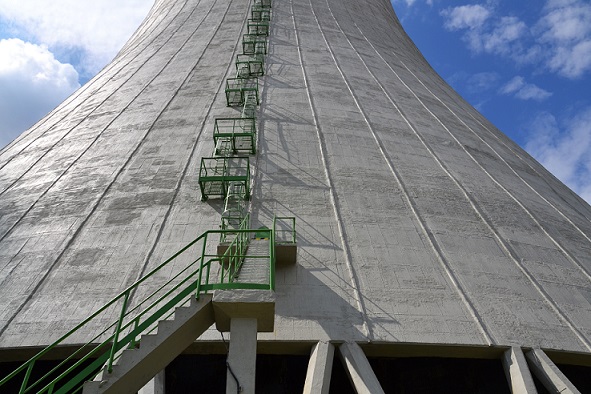
Cold Hard Facts about Nuclear Power


